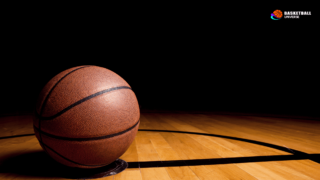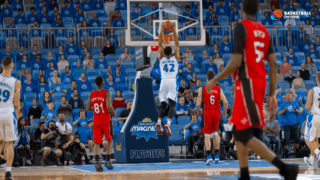
How Long Does Basketball Shoes Last?
Written by: Basketball Universe
Last updated:

As a basketball enthusiast, you already know that the perfect pair of shoes can enhance your game, maximize your comfort, and keep you injury-free on the court. But one question that might be lingering in the back of your mind is, “How long does basketball shoes last?” In today’s blog post, we are going to unravel the answer to this crucial question like a thread on a worn-out sneaker. So, lace up and let’s dive into this fascinating topic that combines technology, wear and tear, and performance, and will ultimately enlighten your path to finding your next perfect pair of kicks.
How Long Does Basketball Shoes Last?
The lifespan of basketball shoes depends on various factors including the frequency of use, playing style, playing surface, and the shoe’s construction quality. Typically, basketball shoes last between 6 months to a year for highly active players, or approximately 350-500 hours of play. However, it’s essential to keep an eye on the shoe’s condition, look for signs of wear, and replace them as needed to ensure optimum performance and avoid injuries.
The Factors Influencing the Lifespan of Basketball Shoes
While it’s difficult to provide a one-size-fits-all answer to the question, “how long does basketball shoes last?”, we can examine the various factors that contribute to the lifespan of your favorite kicks. By understanding these factors, you can maximize the durability and performance of your basketball shoes, ensuring they serve you well on the court.
Frequency of Use
One of the primary factors affecting the lifespan of basketball shoes is the frequency of use. The more often you play, the quicker your shoes will wear down. For instance, a player who hits the court daily will need to replace their shoes much sooner than someone who only plays once a week. To get a clearer idea on the longevity of your shoes, track the rough hours of playtime. As mentioned earlier, 350-500 hours of play is a good benchmark to consider when assessing the durability of your kicks.
Playing Style
Every basketball player has their own unique style of play, which influences not only their performance but also the wear and tear of their footwear. For example, aggressive and explosive players known for rapid changes of direction and sudden stops will experience faster wearing of their shoes. On the other hand, players with a more conservative or relaxed style might see their shoes last longer.
Playing Surface
Where you play basketball also plays a crucial role in determining the durability of your shoes. Indoor hardwood courts are generally the best for the longevity of your shoes, whereas rough outdoor surfaces like concrete or asphalt can wear down the outsoles much faster. If you play primarily in outdoor venues, investing in basketball shoes designed specifically for such environments will help extend their lifespan.
Shoe Construction Quality
Finally, the construction quality and materials used in your basketball shoes are significant factors that affect their longevity. High-quality shoes with proper cushioning, sturdy outsoles, and durable uppers will provide better performance and longer-lasting wear compared to budget options. Additionally, caring for your shoes properly can extend their life, so be sure to keep them clean and dry, and store them in a cool, well-ventilated area when not in use.
Identifying When It’s Time to Replace Your Basketball Shoes
Beyond merely considering the length of time your shoes have endured, it’s essential to recognize the signs that your basketball shoes are no longer providing the support and protection needed to prevent injuries and optimize your game. Pay close attention to the following indicators to make sure you’re replacing your kicks at the right time.
Outsole Wear
The outsole provides necessary traction and grip, which directly affects your performance on the court. If the pattern on your outsole appears worn-out, smooth, or uneven, it’s time to seriously consider a replacement. Losing traction can lead to slipping and potential injuries, so don’t wait too long before looking for a new pair.
Cushioning Deterioration
The cushioning system in basketball shoes is crucial for shock absorption and providing comfort during the game. Over time, this cushioning can lose its effectiveness, even if it’s not visible on the outside. If you start feeling increased impact upon landing or experience discomfort while playing, it may signal that your shoe’s cushioning is worn down and needs to be replaced.
Upper Material and Support
The shoe’s upper material, responsible for securing your feet and providing lateral support, can also wear down over time. Look for any rips, tears, or stretching of the material that could compromise the support and stability necessary for safe and effective play. Keep an eye out for heel slippage, loose laces, or a decline in overall support, all of which signal the need for new shoes.
Getting the Most Out of Your Basketball Shoes
While it’s inevitable that your basketball shoes will wear down over time, there are steps you can take to extend their lifespan and get the most value out of your investment.
Rotate Your Shoes
Alternating between two or more pairs of basketball shoes can help extend the durability of each. Giving the shoes ample time to rest between uses allows the cushioning and materials to rebound and maintain their effectiveness for a more extended period.
Clean and Dry Your Shoes
Keeping your shoes clean and dry can go a long way in extending their life. Excessive moisture and dirt can break down the materials of your shoes over time, leading to faster wear and tear. Wipe your shoes down after each game and allow them to air dry in a well-ventilated area. Proper shoe care can make a significant impact on the lifespan of your kicks.
Invest in Quality
While it may be tempting to opt for lower-priced alternatives or older models when selecting basketball shoes, investing in quality products designed to endure the intense pressures of the game can pay off in the long run. High-quality basketball shoes will typically offer better support, improved durability, and enhanced performance, ultimately saving you money on frequent replacements.
Understanding the Importance of Proper Footwear in Basketball
Basketball is a sport that presents various challenges for your feet and ankles due to its dynamic nature. Investing in suitable footwear that complements your playing style and supports your unique needs can prevent injuries, optimize your performance, and provide the comfort needed for extended play.
Preventing Injuries
Proper basketball shoes play a crucial role in preventing injuries by providing the necessary support, cushioning, and traction on the court. Research has shown that using appropriate footwear can significantly reduce the risk of ankle sprains, one of the most common basketball injuries. Quality basketball shoes that are replaced as needed will help keep you comfortable and safe on the court.
Optimizing Performance
Performing your best on the court is not only about skill and strategy but also about having the right gear. Basketball shoes engineered for your specific playing style and position can help enhance your balance, agility, and overall stability. There are various shoe designs on the market tailored toward different positions, from high-top options offering reinforced ankle support for centers to low-top, lightweight designs ideal for guards.
Comfort and Enjoyment
Lastly, wearing the right basketball shoes can significantly improve your overall comfort and enjoyment of the game. By finding the ideal fit and style to suit your needs, you’ll be able to focus on your performance and have more fun on the court. When your feet feel good, your mind can stay locked into the game, allowing you to reach new heights in your basketball journey.
FAQs: Addressing Common Questions About Basketball Shoes
Let’s tackle some of the most frequently asked questions regarding basketball shoes, their lifespan, and their importance in the game.
Can I Use Running Shoes for Basketball?
While it might be tempting to use running shoes for basketball due to their comfort and lightweight design, doing so is not recommended. Basketball shoes are specifically designed to withstand the multidirectional movements, jumps, and rapid changes in speed common in the game. Running shoes, on the other hand, focus on cushioning and support for linear motions. Using running shoes for basketball can lead to a lack of support, increased risk of injury, and unsatisfactory performance on the court.
How Often Should I Replace My Basketball Shoes If I Play Outdoors?
If you play mainly outdoors, your basketball shoes will likely experience faster wear due to rougher surfaces like concrete and asphalt. In such cases, it’s essential to keep an eye on the shoe’s condition, particularly the outsole and cushioning. As a rough estimate, expect to replace your outdoor basketball shoes every 3 to 6 months, depending on the frequency of use and the quality of the shoes.
Can Inserts or Insoles Extend the Life of My Basketball Shoes?
While adding inserts or insoles to your shoes can provide additional comfort and support, especially for those with specific foot conditions or arch problems, they won’t directly extend the lifespan of your basketball shoes. However, using insoles or inserts can help distribute pressure more evenly, potentially decreasing wear in specific areas of the shoe.
As we’ve seen, a multitude of factors come into play when determining how long basketball shoes will last. By taking good care of your shoes, paying attention to the signs of wear, and investing in quality products, you’ll ensure that your basketball shoes continue to perform at their best, while protecting your feet and facilitating your basketball journey.
Choosing the Right Basketball Shoes for Your Needs
Selecting basketball shoes that cater to your specific requirements can maximize their longevity, enhance your performance, and help prevent injuries. Considering the following factors when choosing your basketball shoes will ensure you make an informed decision, getting the most value from your purchase.
Playing Position
Your playing position in basketball can help determine the type of shoes that would work best for you. Guards, for example, tend to prefer lightweight, low-top shoes that allow for more agility and speed, while forwards and centers may need high-top shoes with extra ankle support and cushioning for better stability during jumps.
Shoe Style
Basketball shoes come in various styles, including high-top, mid-top, and low-top designs. High-top shoes provide the most ankle support but may feel heavier and limit ankle mobility. Mid-top shoes balance support and mobility, while low-top options offer the least ankle support but promote agility and flexibility. Understanding your preferences and requirements can help you pick a shoe style that complements your game.
Material and Construction
The materials and construction of basketball shoes are critical in terms of durability, support, and breathability. Look for durable upper materials with good ventilation and sturdy outsole materials that provide excellent traction. Balancing a shoe’s weight with its level of support and durability will lead to the best performance on the court.
Fit and Comfort
Ensuring your basketball shoes fit well and are comfortable to wear is essential for injury prevention and optimum performance on the court. Different brands and models may fit differently, so it’s crucial to try on various options to find your perfect match. Pay attention to the width, length, and supportiveness of the shoe, and choose something that feels snug but doesn’t restrict natural movement.
Taking Care of Your Basketball Shoes
Proper care and maintenance of your basketball shoes will help prolong their life and keep them in top-notch condition. Follow these tips to keep your shoes performing at their best for as long as possible.
Store Your Shoes Properly
When not in use, store your shoes in a cool, dry place – away from direct sunlight or heat sources – to prevent the materials from breaking down or becoming damaged. Using a shoe tree can help maintain the shape of your shoes while they’re not being worn.
Wash Your Shoes Carefully
Most basketball shoes should not be machine washed, as this can damage the materials and construction. Instead, hand-wash your shoes using a soft-bristle brush, warm water, and mild detergent. Focus on removing dirt and stains from the upper and outsole, and be sure to allow your shoes to air dry completely before storing or wearing them again.
Use a Separate Pair for Outdoor Play
If you play both indoor and outdoor basketball, it’s a good idea to have a separate pair of shoes for each environment. Outdoor surfaces can wear down your shoes more quickly, and dedicating a specific pair to each type of court ensures that your indoor shoes maintain their traction and longevity.
Keep an Eye on Wear and Tear
As we’ve learned earlier in this article, maintaining good basketball shoes requires regular monitoring of their condition. Staying vigilant about signs of wear and tear, such as compromised cushioning or reduced traction, will enable you to make timely replacements and avoid potential injuries on the court.
By taking these factors into consideration when selecting and caring for your basketball shoes, you’ll ensure that your footwear remains effective for longer, benefitting your game and overall basketball experience.
FAQ Section: Common Questions About Basketball Shoes
In this section, we provide answers to some of the most frequently asked questions about basketball shoes. Whether you’re a seasoned player or a newcomer to the game, these insights will help you make informed decisions about your footwear and maximize the lifespan of your shoes.
1. How do I know which size basketball shoe to get?
Ensure an accurate sizing by measuring your feet or referencing your current shoe size from a different pair of athletic shoes. Basketball shoe sizes typically match standard shoe sizes, but different brands and models may fit differently. Trying on shoes in-store is the best way to guarantee the right fit; make sure to wear your game day socks for a precise evaluation.
2. What is the best way to lace basketball shoes for maximum support?
There are several lacing techniques to help provide maximum support. Generally, you should lace your shoes snugly, applying even tension from bottom to top. Using a heel lock technique (looping laces back through the last two eyelets) may offer additional ankle security. Experimenting with various methods can help you find the most comfortable and supportive lacing style for you.
3. How can I break in my basketball shoes quickly?
Wear your new basketball shoes around the house for a few days to gradually break them in before your first game. Light stretching or flexing can also help to soften the shoe’s material. Avoid using any heating methods or soaking your shoes, as these can damage them and void warranties.
4. Are there specific shoe models designed for outdoor basketball?
Yes, certain basketball shoe models are designed specifically for outdoor play. Outdoor basketball shoes tend to have more durable outsoles made to resist rough surfaces like concrete and asphalt. Look for shoes labeled as “outdoor” or with descriptions indicating suitability for outdoor courts.
5. How can I maximize the traction on my basketball shoes?
Keep your shoe’s outsole clean by wiping them with a towel or using a shoe brush to remove dirt and debris. You can also invest in traction-enhancing products like sprays or grip-enhancing pads for the court. Remember, if the outsole is worn out, the best solution is replacing the shoes.
6. Can I wear ankle braces with my basketball shoes?
Yes, you can wear ankle braces with basketball shoes for added support and injury prevention. Ensure the brace fits comfortably within the shoe without causing excessive tightness or discomfort. Some shoes are designed to accommodate ankle braces more effectively, especially mid-top and high-top varieties.
7. Are there basketball shoes designed for players who need more arch support?
Yes, several basketball shoe models provide enhanced arch support for players seeking additional comfort and stability. If you need more arch support, look for shoes with features like reinforced mid-foot support, molded sock liners, or a well-designed midsole. You can also use orthotic inserts or insoles to customize the arch support to your specific needs.
8. How can I tell if my basketball shoes have enough ankle support?
Good ankle support should feel snug and secure without restricting movement. Check for features such as padded collars, robust heel counters, or high-top designs that offer increased stability around the ankle. Ultimately, the shoe should provide stability and flexibility, striking a balance that feels comfortable and supportive during play.
9. Can I use a hairdryer to break in my basketball shoes?
Using a hairdryer to break in your shoes is not recommended, as excessive heat can damage or even warp the shoe’s materials. Sticking to gentle and gradual methods of breaking in your shoes is the safest and most effective way to ensure the longevity and performance of your basketball footwear.
10. How do I clean my basketball shoes without damaging them?
Hand-washing is the best method to clean basketball shoes without causing damage. Use a soft-bristle brush or cloth, warm water, and mild detergent to gently scrub away dirt and stains. Avoid using harsh chemicals or soaking the shoes, and always allow them to air dry completely after cleaning.
11. Are cushioning systems in basketball shoes interchangeable?
While some basketball shoes have removable cushioning systems, most are built into the shoe’s design and are not interchangeable. If you’re seeking greater customization for cushioning, consider using performance insoles to enhance the comfort and support of your shoe’s existing cushioning system.
12. Is it okay to play basketball in shoes with minimal cushion
Featured Posts
- No pillar pages found.





